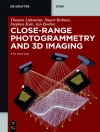Collinear Holography
Provides state-of-the-art, in-depth knowledge on the principles, devices, and applications of collinear holography
In the era of Big Data, traditional magnetic and optical storage technologies are unable to satisfy the growing demand for reliable, scalable, cost-effective, and energy-efficient data storage. Holographic storage, considered the most promising technology for meeting the future storage needs of the information age, adopts a three-dimensional volume storage mode with a theoretical storage density vastly greater than conventional optical disks.
Collinear Holography: Devices, Materials, Data Storage is a comprehensive, up-to-date account of the volumetric recording technology that combines large storage capacities with high transfer rates and exceptional reliability in optical data storage systems. Written by pioneers in the field, this authoritative book provides detailed coverage of the key technological approaches, theories, applications, systems, devices, and components in the rapidly advancing field of holographic data storage.
- Explains the principles of collinear holography, its different system setups, key devices and components, and current challenges
- Describes the materials, data and media formats, servo controls, and read/write characteristics of collinear holography storage systems
- Details collinear holography in current applications such as holo-printing, correlation, and encryption
- Discusses futures technologies including the Holographic Versatile Disc (HVD) and the The Holographic Versatile Card (HVC)
Collinear Holography: Devices, Materials, Data Storage is an indispensable resource for applied physicists, electrical engineers, and materials and information scientists in both academia and industry.
विषयसूची
1. INTRODUCTION
1.1 Big data era
1.2 History of holographic data storage
1.3 Present problems
2. SYSTEM OF COLLINEAR HOLOGRAPHY
2.1 Polarized collinear holography
2.2 Principle of collinear holography
2.3 Collinear recording and reproduction characteristic evaluation device: S-VRD
2.4 B-VRD
2.5 HVD-ES1
2.6 SHOT-2000 (Standard Holographic Optical Tester for Collinear system)
3. THEORIES OF COLLINEAR HOLOGRAPHY
3.1 Analysis of a Collinear Holographic Storage System: Introduction of Pixel Spread Function
3.2 Theoretical treatment of the collinear system and formulate numerical evaluation technique based on the scalar diffraction theory
3.3 Orthogonal reference patterns multiplexing for collinear holographic data storage
3.4 Simulation of interference fringes formed by collinear method
4. KEY DEVICES AND COMPONENTS
4.1 Laser
4.2 DMD
4.3 CMOS
4.4 Servo Actuator
5. MATERIALS
5.1 Holographic media for commercial uses
5.2 Holographic Photopolymer Materials
5.3 PQ/PMMA
6. DATA FORMAT
6.1 3:16 Modulation
6.2 Sync Format
6.3 Reference pattern
6.4 Phase modulation
6.5 Low-Density Parity-Check Code
6.6 Disc Format
7. CHARACTERISTICS OF WRITE AND READ
7.1 Introduction
7.2 Shift selectivity
7.3 Parameters
7.4 Symbol error
7.5 Numerical simulation analysis of collinear shift selectivity
7.6 Summary
8. SYSTEM MARGIN OF a Collinear Holographic Data Storage
System
8.1 Defocus margin
8.2 Detrack Margin
8.3 Image plane margins
8.4 Tilt margin
8.5 Wavelength margin
8.6 Temperature compensation condition for collinear holographic data storage
8.7 Noise Margin
9. APPLICATIONS
9.1 High-speed optical correlation system based on collinear holography
9.2 3D Holographic printer
9.3 Encryption
लेखक के बारे में
Xiaodi Tan is Professor, College of Photonic & Electric Engineering, Fujian Normal University , China. He previously served as a Professor at Beijing Institute of Technlogy, China, and a Senior Technology Analyst, Distinguished Engineer, and Optical Technology Manager of Core Device Development Group at Sony Corporation, Japan.
Hideyoshi Horimai is an inventor of collinear holography. He is currently President of Holy Mine Corporation, Japan, and is a Research Fellow at Institute of Industrial Science, The University of Tokyo, Japan. He worked for more than twenty years at SONY Corporation in optical data storage R&D field.
Tsutomu Shimura is Professor, Department of Fundamental Engineering, The University of Tokyo, Japan. His current research is focused on holographic data storage systems and their recording materials, and dielectric and plasmonic meta-surfaces.
Xiao Lin is Associate Professor, Information Photonics Research Center, Fujian Normal University, China. His research interests are holographic data storage, photopolymer material, phase image retrieval, and 3-dimensional display.











